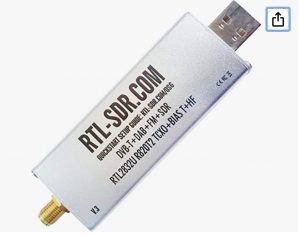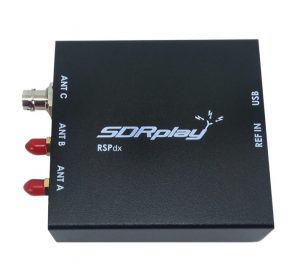RTL-SDR’s are COOL. The list of things you can do with them is almost too long to list here. But know that it ranges from “listening to the radio” to hardcore scientific atmospheric experiments, and everything in between. Hackers can open your car door or garage door with them and private detectives can record the radio signals from your tire pressure monitors to prove you were somewhere you shouldn’t have been. Remember the day when they used to have to sit for hours in a car and take your picture? No more.
I recommend to anyone that will listen that they should have an RTL-SDR in their emergency kit. When I went through Hurricane Florence in 2018 in New Bern NC all local communications went down INCLUDING the NOAA Weather Radio Station. How’s that for a kick in the pants? I watched TV anchors walk off the set due to flooding in their studios. But the police and firemen and Linemen were still out there and I was listening as they restored power to my area. Also having an RTL-SDR during a violent Hurricane KEPT ME ENTERTAINED and kept my mind off of things. AM radio was my best way to stay informed but be warned that some of the SDR’s below need up converters (more hardware) to listen to AM radio or some geek skills to enable the device to listen to frequencies below 24 MHz.
Anyway…….how do you select what SDR you buy? There are lots of them out there and I’ll hit some quick pros and cons on selecting them. If you go to Amazon and search, this is usually the first one that pops up. The RTL-SDR Blog Version 3.

It may be one of the better general purpose receivers and is relatively low cost. Let’s do some pros and cons. There pros and cons are for FIRST TIME USERS AND BUYERS. Not for old pros.
RTL-SDR V3 Pros
- Cross Platform – Windows, Linux, and Mac.
- Coverage is 24 MHz – 1700 MHz. (advertised at 500 KHz – 1700 MHz) (see Cons)
- Relatively low cost.
- Multiple free software choices, some platform dependent.
Cons
- Comes without directions. You have to dig and do a little research to use.
- Needs a special driver for Windows.
- Needs packages installed in Linux or Mac.
- To get below 24 MHz (short wave radio, AM radio, etc.) you need software that allows you to access Direct Sampling Mode. Translation: It’s not “out of the box, plug and play” easy to listen to AM radio (unless you are an old pro).
I should add that the pros and cons for many USB receivers similar to the V3 are going to be the same. Nooelec makes a line of receivers called NESDR that work essentially the same way with roughly the same coverage. And again, all the instructions for driver installation and setup will be online.
Now lets bump up the game a little and alleviate some of the Cons.
SDRPlay

RSPdx
SDRPlay has several offerings which solve some of the cons from above. But as you might have guessed you are taking a bump up in price.
The RSPdx (shown here) costs $300. Yikes!
But you are getting a way more capable receiver.
That being said, if all you are ever going to do is to listen to FM radio ……….this is money poorly spent. If you want to push RTL-SDR to it’s limits…….this is the route you want to go.
PROS
- Coverage of SDRPlay receivers is roughly 0 KHz to 2000 MHz. That’s basically EVERYTHING. And you don’t need additional hardware or geeky tricks to listen to AM or shortwave radio.
- Multiple antenna ports and connectors (some models).
- Great specifications.
- Excellent electrical shielding.
- Single download package includes drivers and software.
- Will eventually have cross platform software called SDRConnect however this has been promised in their development roadmap for YEARS. It does seem to be coming along though as they are demonstrating it at Ham Fests currently.
CONS
- EXPENSIVE
- Included software (SDRUno) is Windows only.
- There are solutions to use on Mac and Linux but they are inferior to SDRUno.
- While the software is POWERFUL it has a STEEP LEARNING CURVE.
- Considerably larger than the V3 or Nooelec offerings. Still portable but not as portable for an emergency bug out situation.
Airspy

Airspy HF+
I like Airspy for a couple of reasons. Whereas SDRPlay stuff plays nicest with its own software, the Airspy stuff works with all the great free SDR software that is out there on Windows, Mac, and Linux.
Sadly they don’t make any 0 KHz to 2000 MHz offerings. Everything is either HF (0 – 30 MHz) or 24 – 1700 MHz.
To get the full range you need to buy their Upconverter, the Spyverter. My greatest SDR pro tip hardware buying guide is this:
Buy an Airspy HF+ for Long, Medium (AM), and Short Wave reception. The HF + also covers FM radio, NOAA radio and Air Band and some analog Police/Fire/EMS stuff. And then use a V3 or Nooelec NESDR for UHF stuff.
PROS
- Best AM and Short Wave reception with the HF+
- Way more cross platform than SDRPlay
- Their Software SDRSharp (SDR#) is easy and powerful but Windows only
- Works EASILY with GQRX, SDR++ , SDRAngel and many other cross platform SDR software packages.
- SpyServer software makes it easy to share your SDR across your local network and to other users on the internet all over the world.
CONS
- Not full coverage receivers.
- Need extra hardware to receive AM and Short Wave radio.
- Can’t use geek tricks to get you AM or Short Wave radio.
- Expensive
So, I’ve really only covered 4 manufacturers. There are SOOOOO many more out there but for people just getting started with software defined radios these are going to be the names that pop up the most, and that have the best documentation for getting started.
One of the best ways to get started is to read this book . Most of the information contained in it is online however you’ll never know to look for that information until you know it exists. I consider myself an old SDR pro but I have this book and I use this book to this day. You’ll be stunned at the things you can do with the information contained within its pages.
Wanna do something cool and scientific and family oriented with your kids to keep them out of trouble? Teach them to track aircraft or ships at sea or download photos from a weather satellite. Wanna win the class Science Fair? Pick an SDR experiment.
My recommendations are as follows:
- For an emergency kit – get a V3 or Nooelec and get software that supports putting the device in Direct Sampling Mode so you can listen to AM and shortwave radio (GQRX or SDR#, and others)
- For radio hobbyists who want it all in one package – get an SDRPlay RSP1A but know that to get the most from it you need to operate SDRUno on Windows only.
- For the best Medium and Short Wave listening – get an Airspy HF+. If you need more VHF and UHF coverage then pick up a V3 or NESDR.
- For the Windows hater and Mac and Linux user – get a V3, NESDR, or Airspy device, or one of each.
- For the super geek – get all of them! Be like me!

A con for the SDR Play is it was unusable with SDR Trunk without pulling teeth. In June 2022 this may or may not still be the case?
I haven’t played with SDRTrunk for a while but that doesn’t surprise me. I don’t think SDRPlay works with DSD+ either.
I’ve been very happy with my afedri sdr units, and there is Windows and Mac software available.
If you want to listen to AM radio in a emergency / disaster situation, for heavens sake get a AM/whatever radio. Why screw with dongles, upconverters, antennas and computers in a stressful situation?
Or a good portable SDR multi band like Malahit DSP2 ($300 to $400) if you crave a portable waterfall verses a plain ol’ multi band shortwave radio for $50 to $250).